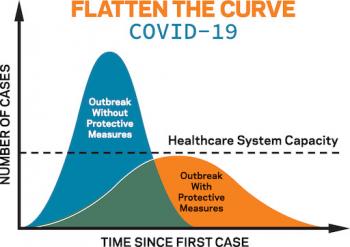Maine may be ‘bending the curve,’ but that doesn’t mean it’s time to relax
With so much unknown about the spread of COVID-19, most experts, including Maine Center for Disease Control and Prevention head Dr. Nirav Shah, are relying on data projections to inform policy with the hope of slowing the rate of transmission. In Maine, some of these data suggest that the state could be “bending the curve.”
“There are some hopeful signs that the social distancing is having an impact,” said Dr. Dora Anne Mills, a former top state health official and current senior vice president of community health for MaineHealth. Dr. Mills, who is also the sister of Maine Governor Janet Mills, said she’s been looking at averages of cases identified by testing, as well as monitoring hospital and fatality data, and has observed some “preliminary good signs.”
However, she cautioned, “we’re still early on in the surge in Maine, and one major outbreak,” for instance in a nursing home or among Portland’s homeless population, “could cause the numbers to surge.”
Bending the curve
Alan Cobo-Lewis, a professor and head of the Center for Community Inclusion and Disability Studies at the University of Maine, has been creating charts based on the number of cases confirmed by the Maine CDC and sharing his impressions on social media.
On April 5, Cobo-Lewis wrote that in the face of the sad news of the latest COVID-19 fatalities, “there is welcome news on the number of new cases — in the sense that the number of new cases reported Sat 4/4/2020, while far above the 0 that we would want, was below the 61 that I’d predicted last night from the Maine data through 4/3/2020.”
On April 6 he followed up, noting that the “29 new cases [were] very close to prediction. Still consistent with bending the curve in Maine.”
Bending the curve means reducing the transmission of the virus to prevent a sudden and large spike of patients with COVID-19, which could effectively overwhelm a local health care system.
And on April 7 Cobo-Lewis wrote “20 new cases on 04/07/2020 somewhat below prediction of 27.5. Still consistent with bending the curve in Maine.”
One of the numbers public health experts are closely tracking is the “doubling time,” or amount of time it takes for the number of newly confirmed cases to double. On April 7, Cobo-Lewis wrote: “Doubling time lengthened to about 3 days by March 18, lengthened slowly for a couple weeks, and seems to be currently lengthening at that rate or maybe somewhat faster.”
He added that while “Things certainly could change […] at the moment the trend is encouraging on new cases in Maine.”
Signs that physical distancing is having an impact
Maine currently holds a B- in a social distancing scorecard created by the data firm Unacast, using cell phone data to track whether people are changing the amount and distance that they are traveling during the current lockdown.
State traffic data also shows greatly reduced movement, especially in southern Maine.
During a press conference on Tuesday, Governor Janet Mills repeated the need for Mainers to abide by the restrictions and stay home, emphasizing that this remains the most effective way of preventing a spike in transmission.
Dr. Mills credited any positive developments to the physical distancing measures and warned that such projections could quickly change.
“We know there is a lot of virus circulating, so we’re also on egg shells, making sure the social distancing measures remain intact,” Dr. Mills said. “If they were to be relaxed right now, with so much community transmission of COVID, we could easily have a major surge. So, too early to call it preliminary good news, but I’d say we have preliminary good signs.”
Without widespread testing, ‘we don’t know the true numbers’
Health policy expert Mitchell Stein calls these relatively positive indications “one possible future.”
“Positive projections about ‘peaking’ and ‘bending the curve’ are encouraging but are not signs that we can let our guard down any time soon,” he said.
Projections of the virus’ spread are hampered by the fact that current models rely on positive tests reported by the Maine CDC, which does not include the unknown number of cases where Mainers have displayed symptoms but aren’t being tested because they are not considered to be in a high risk category.
“Without widespread testing,” Cobo-Lewis noted, “we don’t know the true number of cases in Maine, which is surely higher by some unknown amount.” However, he added that unless the testing criteria has changed, “the patterns in this data set ought to still be informative.”
Dr. Mills also advised against putting “too much weight” on the accuracy of a number of cases based solely on testing.
The only way this ends
Even with the hope implied by terms like “bending the curve” or “lengthening the doubling,” Stein emphasized that neither means Maine is in the clear.
“Let’s remember what the phrase ‘bending the curve’ means,” he said. “Bending the curve means having fewer cases at any one point in time. […] It is NOT about ending the pandemic.”
“The only way this ends is if either everyone — 60-80 percent of the population — gets sick, or if there is a vaccine, or there is a treatment that works quickly,” said Stein. “Absent any of those three options, people will continue to be at risk of getting sick and the need for social distancing will continue.”
Lauren is the editor of Beacon. Prior to joining MPA, Lauren worked at Common Dreams and her writing has also been featured on BillMoyers.com, TruthDig, Truthout, In These Times, People’s Action blog, FAIR.org, Newsweek, and EcoWatch. She has also worked on a number of documentary films, including one in current production on civil rights icon James Meredith.


























